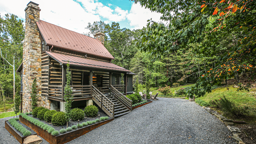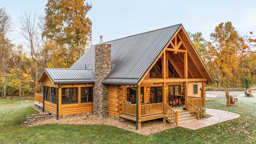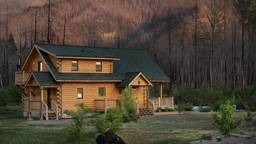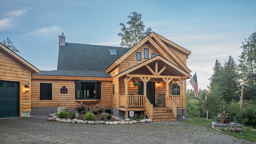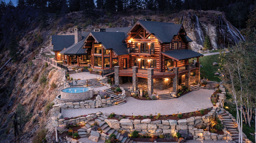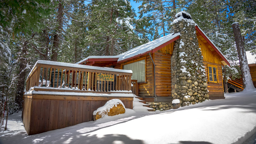Story and Photos by Joe Hilliard
When Dan and Beth decided to build their waterfront log home on the Missouri River, little did they know what this seemingly simple process held in store. They only knew that they had long wanted one.
When Beth was a child, her family visited the grand hunting camps in the Adirondacks and National Park lodges out West. Dan grew up hunting and fishing along the Missouri River in South Dakota on land that had been in his family for seven generations.
The two even spent their honeymoon in a Colorado log cabin. The site they purchased to build on was a historic cottonwood forest on the Missouri, just south of the land that Dan explored as a boy. The couple later discovered that Lewis and Clark camped at a site almost directly across the river from them in August 1804.
The couple didn’t want to use an existing plan for their waterfront log home because they wanted it to be a one-of-a-kind sanctuary that would reflect their ideas and vision.
When they would go out to dinner, they often sketched their ideas. They also bought log-home magazines and clipped pictures of features they liked. Eventually, they transferred their design ideas to graph paper and went to log-home shows in Minneapolis to find a company to help deliver their dream home.
Golden Eagle Log Homes, a Wisconsin manufacturer, offered the flexibility that they wanted. It translated the couple’s plan into final drawings, keeping the footprint as rectangular as possible to keep the home’s cost well within budget.
Besides intending to build the home themselves, Dan and Beth wanted their waterfront log home to be as green as possible, so they carefully selected sustainable products.
They considered aesthetics and design, as well as their home’s impact on the environment. To that end, they installed a geothermal heating system that consists of four large vertical loops of liquid-filled tubing that run underground to extract heat from the earth and store it in the thermal mass of the Lite Form insulated concrete form basement.
Ten-inch, kiln-dried eastern white pine logs also increased the mass density of the home. The couple designed 3-foot-wide roof overhangs to shade direct sunlight in the summer and collect warmth from the lower-angle winter sun.
They also kept as many trees as they could to add shade and keep the home cool in summer. The double-hung windows are coated with a solar film that boosts efficiency. The roof’s dark green heavy asphalt shingles provide not only additional insulation and sound muting, but also a beautiful visual contrast to the honey-colored exterior logs.
The exterior stone, laid by Dan and his son, was sourced locally. Dan and Beth chose 3/4-inch re-purposed hickory for the floors, which Dan installed, and hickory cabinets for the kitchen. The linoleum used for flooring in several areas of the home is considered a sustainable resource, as is the cork floor in the dining room.
Both materials feel soft underfoot but also soften sounds in the home. In the kitchen, an Elmira Stoveworks vintage stove is a focal point where family and friends gather when the couple entertains. The bedrooms and loft area have carpeting that was created from recycled materials. Eye-catching black quartz countertops with chiseled edges contrast with the light wood and smooth finish of the hickory cabinets.
All of the construction materials except the cork flooring were produced in North America. Dan and Beth began construction on their waterfront log home in spring 2010 while snow was still on the ground. Work proceeded smoothly until the summer rains began to fall at an alarming rate. Dan recalls that it rained hard almost every third day for many weeks.
The following year, winter snow melt and the historic rainfall caused reservoirs upstream from the site to fill up to the point where large amounts of water had to be released. The onrush washed out their road and caused floodwaters to rise dangerously close to the house.
Dan had to rush to build a berm to keep the water from reaching the house. Eventually, it rose to such levels that the couple had to park at a neighbor’s farmhouse, a mile and a half away, and then use a small motorboat to cross fields and the farmer’s fences to reach their home.
They continued to work on the inside every day while keeping a close watch on the rising waters. Dan periodically got out with his skid loader to raise the height of the berm to stay above the rising water, ultimately ending up 6 feet tall to keep the water out.
After several months, the water began to recede, and the couple was able to relax and concentrate on finishing the home. They aren’t worried about this happening again in their lifetime since hydrologists and other experts said they considered it to be a 500-year flood. Dan and Beth completed their waterfront log home shortly before their 30th wedding anniversary.
Many of the items they used to furnish it are antiques and heirlooms from both sides of the family. Dan’s toys and fishing-hunting gear from his youth also fill the rooms. Several items were repurposed, such as the large mirror in the master bath, which once hung in Dan’s mother’s home, and an antique icebox that now holds china.
A canoe from the late 1800s hangs high up in the rafters of the great room. The home stands today along the Missouri River as a testament to the couple’s pioneer spirit. Besides building the home themselves, they stood up to nature’s adversity to create the sanctuary they call home.
Home Details
Square Footage: 3,216 (not counting basement)
Bedrooms: 3
Baths: 2.5
Log Provider: Golden Eagle Log Homes















